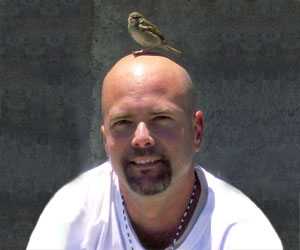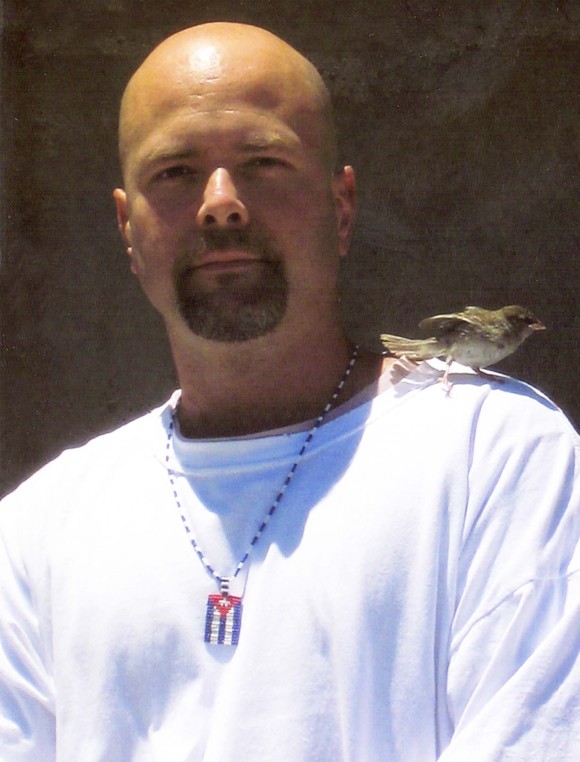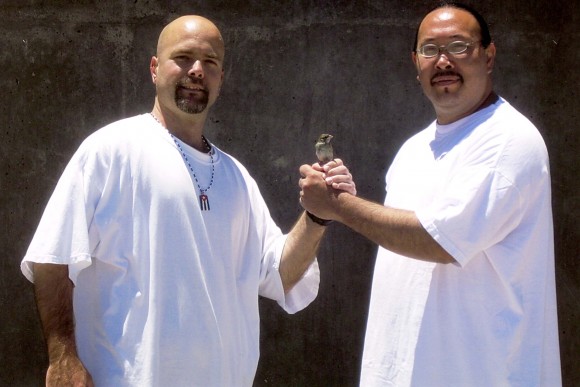Translation: Machetera
En Español
 Once upon a time, a bird made friends with a prisoner. Both were incarcerated in the United States and both were unjustly imprisoned for defending Cuba from terrorist activity.
Once upon a time, a bird made friends with a prisoner. Both were incarcerated in the United States and both were unjustly imprisoned for defending Cuba from terrorist activity.
This is how the story began. On June 4, 2009, the same day as his birthday, Gerardo Hernández heard about this creature. He found out about it through a prisoner whose last name was Lira, who worked in the prison factory. Lira and a guard were cleaning the roof with a pressure hose and without meaning to or perhaps without knowing, they destroyed a nest that contained three chicks. Two of them died instantly but one remained alive. They were so tiny that they didn’t even have any feathers. It’s possible that they had just barely hatched.
The guard was visibly moved, and feeling responsible, allowed Lira to bring the chick secretly inside the prison to try to save it. The prisoner arrived with the chick in the palm of his hand and not knowing what to do with it, began to ask the other prisoners what to do. Someone suggested: “Ask Cuba [the nickname the prisoners had given Gerardo]; he likes animals and surely he will know what to do.” That’s how Gerardo came to be summoned, and he came to the cell where they kept the bird.
Gerardo’s first reaction was to whistle, imitating what he imagined the chick’s mother would have done. He moved his fingers as though they were little wings. Miraculously, the little bird opened its beak. Gerardo began to give it breadcrumbs and later, dipped his fingers in water and let the drops fall softly into the little bird’s beak.
Gerardo didn’t want to take the bird to his cell, but every day he went to feed it. The problem was that at the beginning, the bird didn’t want to take food from anyone except Gerardo. One day it occurred to Gerardo to offer the chick a few slivers of fish, and afterwards the rascal didn’t want breadcrumbs any more. His feathers began to grow and so Gerardo taught it to eat on its own. He put the bits of food in the palm of his hand and the little bird came fearlessly.
However, the prisoners were worried. If an inspection were to happen, the little bird would be a problem. Since he was already quite a bit bigger, they let him loose in the patio so that he might fly free. The bird flew a little while and then returned to Gerardo’s shoulder. Every time he tried to fly with the other birds, they rejected him with little pecks. Little by little he gained confidence. Gerardo went alone to the wing where his cell was, but when he returned to the patio, the bird also returned to see him.
Once there were many prisoners in the patio. Someone told Gerardo that the bird was perched on the concertina wire surrounding the prison. Gerardo whistled, and in front of all the prisoners, the little bird appeared out of nowhere and landed on his shoulder. Incredible. Everyone talked about it.
The little bird was named Cardinal, because Gerardo had painted its tailfeathers with a red marker to distinguish him from all the rest. The ink affected the bird a bit. It lost its tail feathers but only for a little while. Later they grew back, in their natural color. However, the name remained: Cardinal.
On a different occasion another prisoner found the little bird in the patio with its beak stretched open. It was very hot, and the bird was thirsty. Gerardo gave it water. He hid the bird under his hat in order to go inside without the bird being seen. Of course the guards realized he had something odd on his head. “What’s under the hat?” they asked, and Gerardo answered, “Nothing.” Cardinal answered as well, whistling like crazy. “Don’t tell me you’re training him to take messages to Fidel,” said one of the guards, laughing.
The story didn’t end there. Gerardo brought the bird to his cell and made a nest for him to stay there with him. He played with him, letting him rest on his shoulder, or on his head. When Gerardo was writing, the bird came to play and Gerardo would pet him gently, to calm him. So Cardinal would run along his back, where he’d be out of reach. Sometimes he curled up inside Gerardo’s collar and slept there. Or he pecked at his friend’s ear and when Gerardo moved his head, he’d go for the other ear.
Once when Gerardo had let Cardinal go, he flew toward the cafeteria and landed on the plate of a very large, tough prisoner who was eating a piece of chicken. The prisoner caught the bird in his hands, meaning to strangle him and someone shouted, “Don’t kill him! He belongs to Cuba.” The outcry took the prisoner by surprise. He let Cardinal go and asked, surprised, “And who the hell is Cuba?”
Gerardo was actually very worried. A certain guard was not showing any mercy toward the little bird. During an inspection, the guard had forced Gerardo to let Cardinal go, and closed the door behind him. The little bird returned later, completely exhausted. Gerardo let him rest for a few days inside his cell. And then came the lockdown (solitary confinement as punishment for all prisoners), and whenever there’s a lockdown, there are inspections.
When Gerardo heard that they were checking all the space between the floor and the door, he pushed Cardinal outside. Cardinal flew, within the wing where Gerardo’s cell was located. When the guard arrived, he saw the box where Cardinal lived. Gerardo said that this was where his friend lived, of his own free will: “The problem is that I take him outside and he returns; it’s not my fault.”“Look,” said the guard, gesturing as though to say he thought Gerardo was nuts, “if you think I’m going to believe that bird is going to return…” Gerardo whistled from his cell and the guard froze in his tracks as he watched the bird return. Cardinal had no problem picking out the cell belonging to his friend, among the huge array of cells on two floors that looked exactly alike.
Cardinal arrived at Gerardo’s cell. He looked at him through the bars but couldn’t enter (since this was lockdown). He waited there nervously, until Gerardo couldn’t stand it any more and opened the slot where food was delivered, and Cardinal came in. A few days later there was another inspection. When the guards arrived at Gerardo’s cell, he told them that he had a small bird, so they wouldn’t be scared if the bird should happen to fly overhead. He was told that he had to release it, but since none of them could catch the bird, they brought Gerardo to the entrance for the entire wing so that he could let it go himself. Since they were in lockdown, Gerardo and the little bird walked down the passageway, escorted by the guards. All the other prisoners saw them through the bars of their cells and began to shout: “They’re taking Cuba and the bird to the hole!” as they banged their doors in protest. The guard shouted, “Calm down! He’s not going to the hole; we’re just going to free the bird!”
That was the last time that Gerardo saw Cardinal. The lockdown lasted a month while the wing was completely shut down. Gerardo couldn’t leave and Cardinal couldn’t enter. The little bird had been inside this rough high-security prison since Gerardo’s birthday, from June 4th, and he remained there until July 16th, one day after the wedding anniversary of Gerardo and his wife, Adriana.
And that’s the end of this (true) story.




Alicia Jrapko wrote this story from memory, two hours after hearing it from Gerardo during a visit to the maximum security prison in Victorville, California. Gerardo later revised and corrected the text, which Alicia plans to present to Casa Editora Abril so that it can be published as a children’s story. Gerardo is incarcerated under a double life sentence plus 15 years, for unproven charges made against him in a highly prejudiced trial in Miami.
Gerardo Hernández Nordelo was born in Havana on June 4, 1965; the third child of Gerardo Hernández Martí and Carmen Nordelo Tejera, both deceased. He is a graduate of the Raúl Roa García Foreign Services Institute (ISRI). One year before graduating, he and his wife Adriana Pérez O’Connor were married. He is a cartoonist and graphic artist who has worked in both Cuba and the United States. In the mid-1990′s, he served missions in the United States, designed to protect Cuba from the terrorist actions planned and executed by counter-revolutionary organizations located in Miami. On September 12, 1998, he was arrested along with four other men and subjected to a trial plagued with irregularities and prejudice, in Miami. He was convicted, without any evidence whatsoever, and sentenced to two life terms plus 15 years, which he is serving in a high security prison in Victorville, California.
Machetera is a member of Tlaxcala, the network of translators for linguistic diversity. This translation may be reprinted as long as the content remains unaltered, and the source, author, and translator are cited.